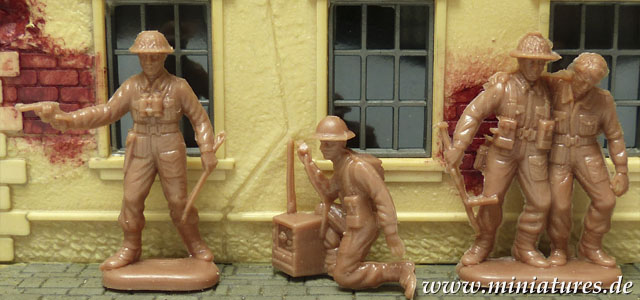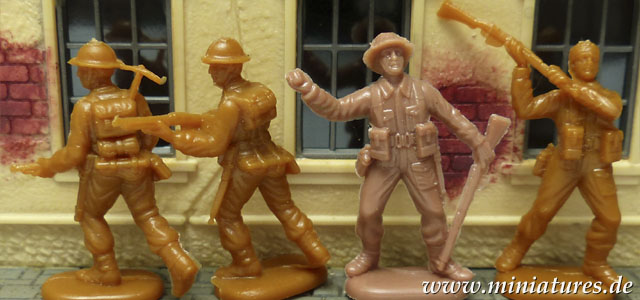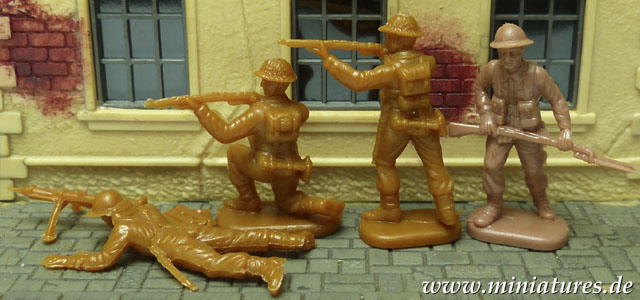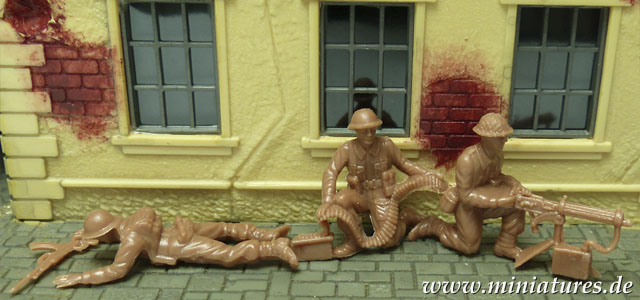British Infantry, 1941–1945
ESCI 1:72 Scale Figure Review

ESCI British Infantry wearing Battledress with ‘37 Pattern Webbing in Battle Order, and the Mk.1 or Mk.2 helmet which was worn throughout World-War Two, even after the Mk.3 “Turtle Shell” helmet was issued to assault troops participating in the Normandy landings in Juni 1944. Strangely, six of the 15 figures in this set are actually looking straight at the camera, instead of looking at what they are doing. Some turning of heads will be required to fix this.
Contents
50 Figures in 15 Poses – 24 mm equal 173 cm Height
- Officer with Webley .38/200 Service Revolver and Swagger Stick (2)
- Radio Operator with No.18 Wireless Set (1)
- NCO with Thompson Machine Carbine, advancing (6)
- NCO with Thompson Machine Carbine and Pickaxe, running (6)
- NCO with Sten SMG, assisting wounded Soldier (2×2)
- № 1 PIAT with Projector Infantry Anti-Tank (2)
- № 1 Bren with Bren LMG (3)
- Rifleman with fixed Bayonet, advancing (3)
- Rifleman, throwing Hand Grenade (3)
- Rifleman, standing, firing (6)
- Rifleman, kneeling, firing (6)
- Rifleman, wounded, clubbing with Rifle (2)
- № 1 Vickers with .303 Vickers MMG (3)
- № 2 Vickers with .303 Ammunition Belt (3)
Evaluation
Excellent choice of subject, these British Infantrymen and their support weapons may be used to recruit infantry platoons and machine gun sections seconded from HQ Company.
The infantrymen are wearing Battledress with 1937 Pattern Web Equipment in Battle Order. Unlike many other figure set in this scale, most of the figures are actually wearing the Small Pack, almost everyone has an entrenching tool in its Carrier, Entrenching Tool and a Water Bottle and they are even carrying these items correctly. This is quite unusual, because ESCI miniatures often carry equipment inconsistently even within the same figure set, with an ammunition pouch placed on this hip or the other, as the sculptor sees fit, even if the soldier will not be able to reach into it with his right hand.
Having said that, the officer is not carrying the smaller Haversack, Officers, introduced in 1938. He does have a Pistol Case, but his Pistol Ammunition Pouch and Compass Pouch are missing. The officer is brandishing his Webley Service Revolver in the direction of someone, without actually looking at his supposed target. He has binoculars, but no Binoculars Case to secure them in.
The radio operator, too, is holding the transmitter into the air absent-mindedly, instead of speaking into it or at least looking at the No.18 Wireless Set to see which dial he needs to turn next. This figure needs to have its head set in the proper direction.

There are too many submachine gunners and not enough riflemen in this set to recruit a full-strength British infantry platoon. The Thompson machine carbine was expensive and in such short supply at the beginning of the war that only one could be issued to the infantry section. In preparation for raids, the Commandos were issued more Thompsons than the infantry, and this is an opportunity to redeploy many of the submachine gunners from this set to the Special Service Brigade.
The soldier throwing the hand grenade is an awkward pose which should get him a -2 modifier for accuracy in most wargames. If his head was removed, pinned with 0.6 mm piano wire and turned to the left, he might actually have a chance of seeing and hitting his target. The wounded rifleman next to him is also looking straight ahead, but attempting to strike an enemy to his left. While these postures ensure that the faces are not marred by mould lines down the middle of the forehead, they just look silly and need to be corrected.

The prone PIAT gunner No. 1 appears to be dazed and cowering, unable to fire his weapon at any enemy tank. He has his head down, looking into the ground, instead of aiming and firing the PIAT. In addition, he is holding the weapon incorrectly with only one hand. Small Arms Training, Volume 1, Pamphlet No. 24, Projector, Infantry, Anti-Tank explains how it must be done properly: “Hold the projector firmly into the shoulder with the left hand either over the webbing gaiter or grasping the front of the trigger guard; place the thumb of the right hand behind the trigger guard grip and the first two fingers on the trigger. Aim as taught.”
“After firing, No. 1 will observe the flight of the bomb. No. 2 will reload immediately, first making certain that the spigot is not showing. Owing to the limited range of the weapon, quick reloading is essential in case the first bomb misses the target.” Since there is no No. 2 in this set, wargamers may want to recruit the Airfix British Infantry PIAT gunner for this vacant position instead.
The PIAT itself is modelled incorrectly on a bipod, when this weapon actually had a monopod.

Like the PIAT gunner above, the prone No. 1 Bren gunner appears to be wounded or dazed and cowering. He is not moving, aiming or firing his weapon, but looking down into the ground instead. The No. 2 serving the .303 Vickers Medium Machine Gun is looking straight ahead, instead of watching how he needs to be feeding ammunition into the weapon. To fix this, remove the head from the figure, pin it back on with 0.6 mm piano wire and turn the head towards the Vickers MMG.
Historical Employment
- British and Commonwealth Infantry, 1941–1945
Possible Conversions
- British Infantry in Khaki Drill Service Dress (KD SD), 1939–1942
- British Infantry in KD tropical Dress re-dyed Jungle Green, 1942
- British Commandos with Berets, 1941–1945
- Indian Infantry with Turban, 1941–1945
ESCI British Infantry offers a nice selection of Officer and NCOs, riflemen and support weapons, but there are so many absent-minded soldiers among them that one cannot help but wonder how well they might perform in wargames.